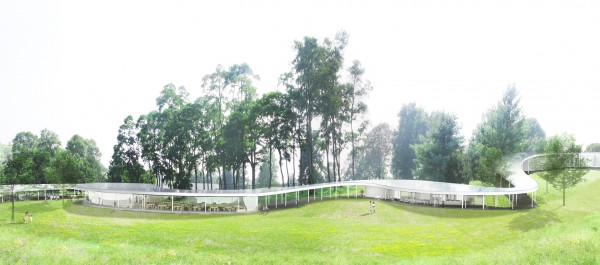The River rises in New Canaan
When Grace Community Church congregants gather at The River ”” a new community center at Grace Farms ”” Oct. 11, they will worship among 80 acres of God”™s green Earth in New Canaan. Their journey through a wilderness of bearing witness in unused school spaces will have ended at the doors to a new 86,000-square-foot facility that mimics a pristine river in all its symbolic, subtle power.
Given that work on the unique, serpentine building is 75 percent complete, the project as presented on a recent hard-hat tour has vaulted from “In the beginning” to “And it was good.” It is mostly glass ”” low-iron, low-lead and super-clear ”” as if “Let there be light” were a design dictate from above.
The tour capped eight years of planning and two years of construction. The official opening is Oct. 9, with a community day Oct. 10 and the first services Oct 11.

- The River sanctuary and community center in New Canaan. Photo courtesy Grace Farms Foundation and SANAA
The price tag is $60 million, with details including:
Ӣ an 11,000-square-foot sanctuary with 700 seats that will be a music venue, as well;
Ӣ a 6,900-square-foot commons with dining and living areas able to accommodate 300;
Ӣ a 950-square-foot pavilion welcome center and music venue; and
Ӣ a 7,500-square-foot multiuse gymnasium with an adjoining media lab and game room.
“It will be an open, welcoming place where people can explore nature, foster community, explore life and work toward the common good,” said Sharon Prince, president of the Grace Farms Foundation, which spearheaded the project. “This will be a nexus for organizations to flourish and for emerging justice initiatives.”
The gym at one end of The River and the sanctuary at the other end, plus three more meeting spaces in between, are called walled volumes. They are connected under one fir-sheathed roof, with some lengths of the walkway left open to the elements so animals can pass through and so people can more easily interact with nature. Fifty-five 500-foot-deep geothermal wells help cool and heat the building.
In a statement, Grace Farms said, “Members of the public may share a meal in the dining room, make use of the library, enjoy one of the artistic programs that will be woven through Grace Farms or simply relax in the natural setting.” Prince further said the center will be open for business gatherings but only to nonprofits.
Peter Miller of New York City-based Handel Architects, executive architect for the project, said, “It is a rare type of building that included some challenging aspects. It has some of the largest curved insulated-glass plates in the world.” The glass panels ”” about 7 feet by 13 feet ”” were fabricated with minimum iron and lead in the U.K., bent in Spain and installed by a German company. All 203 curved panels possess unique curvature. Only 30 panels are flat.
The building was designed by Japanese architectural firm SANAA and principals Kazuyo Sejima and Ryue Nishizawa, who soon after accepting the Grace Farms Foundation contract for The River won architecture”™s prestigious Pritzker Prize.
The River by design connects people ”” and their thoughts and actions ”” as it flows down a landscaped hill. “It is a place of peace and respite,” Prince said. “A place to pause and reflect.”
Yuko Hasegawa, chief curator of the Museum of Contemporary Art in Tokyo, said in a statement issued by the Grace Farms Foundation, “The SANAA architectural experience encourages the emergence of various relationships by loosely connecting the public and the private, the group and the individual, and the external and the internal.”
Prince said the SANAA idea was for the building to disappear into the landscape while at the same time promoting interactions. She called it “a new concept and a whole new paradigm.” On-site community gardens are among the foundation’s plans.
“It will be a nexus for organizations to flourish and for emerging justice initiatives,” said Prince, who led the hard-hat tour. “We”™ve been working on this eight years,” she said while demonstrating the Americans with Disabilities Act-compliant elevator. Construction began in 2013.
The site features a pair of separate barns that had formerly been connected. One will be for church use and the other for on-site activities and initiatives.
The church to date has met in local schools. It will now trade Formica tables for SANAA-designed tables milled from trees felled for the project, part of the entire site”™s sustainability blueprint. This is the church”™s first dedicated facility.
Miroslav Volf, Yale University theology professor and Grace Farms Foundation board member, said, “Grace Farms will be a setting in which to seek answers to the fundamental human question of what makes our lives worth living. Who am I? What should be my relationship with others? What can I do that will make an imprint worthy of the name of being human? In its natural setting, its architecture and its programs, Grace Farms will provide rare opportunities of space, time and occasions to engage with these issues and, by doing so, to open ourselves for the encounter with God.”
This article has been updated to reflect that The River in New Canaan is a project of the Grace Farms Foundation that is 75 percent complete. The building, which features 203 curved glass panels, consists of multiple “walled volumes” connected under one roof, with some lengths of the connecting walkway left open. Details of the project, including the role of Grace Community Church, which will use the facility, were incorrect in a previous version.